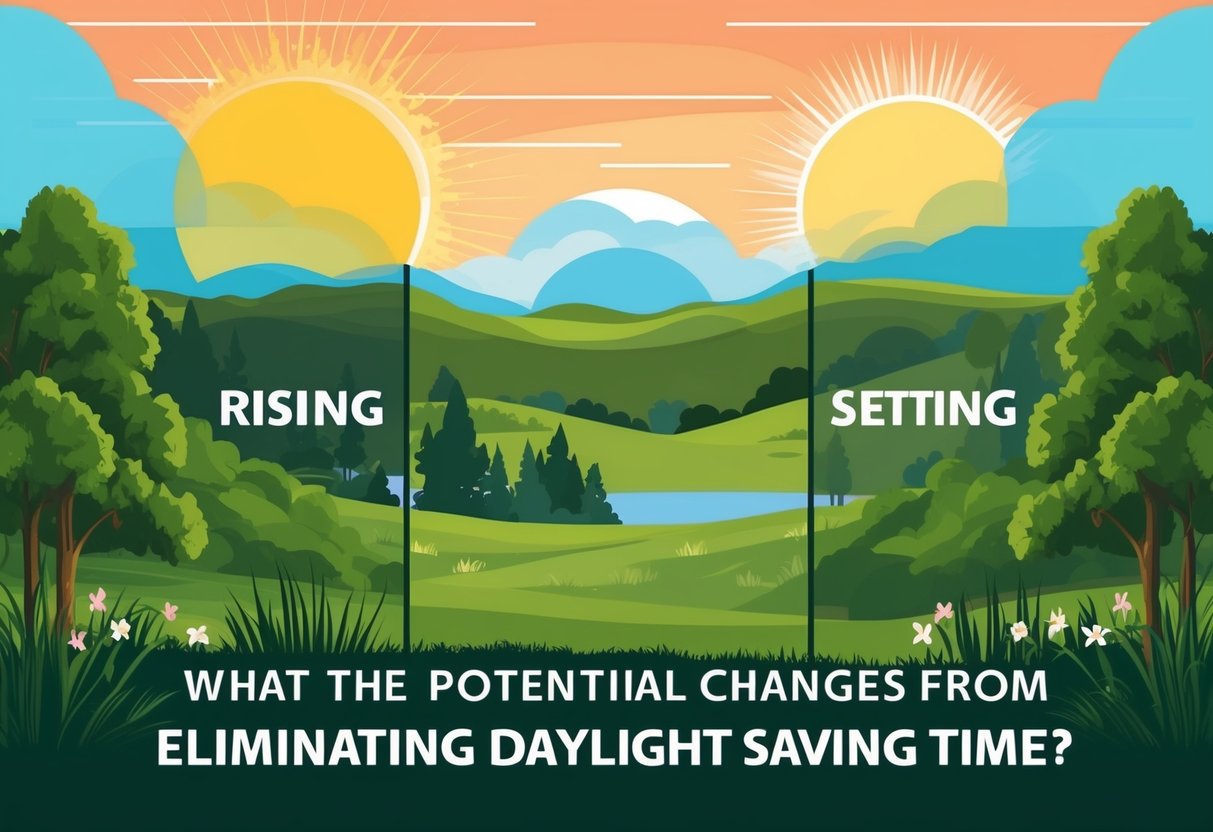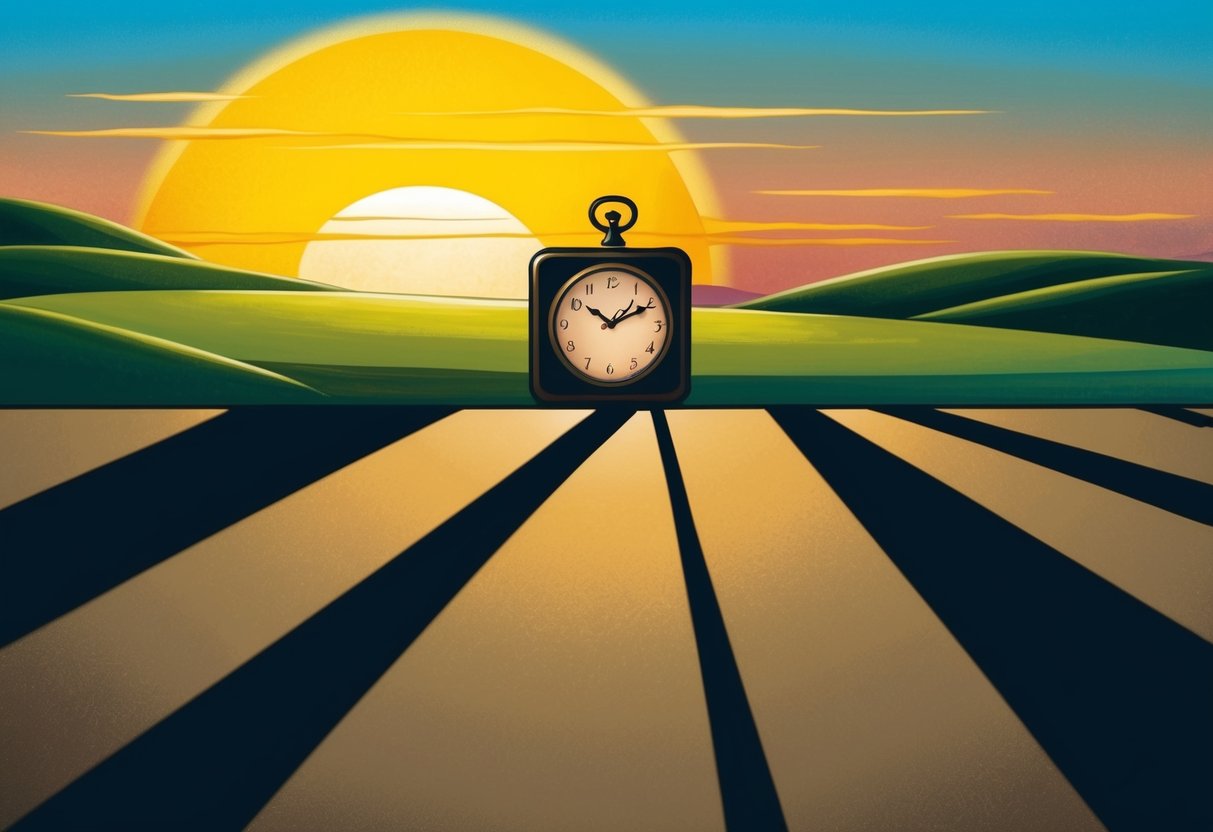Daylight Saving Time has been a part of our lives for decades, but its potential elimination could bring significant changes to our daily routines. The practice of moving clocks forward in spring and back in fall affects when we see the sun rise and set.
Eliminating Daylight Saving Time could result in earlier sunrises and sunsets throughout the year, altering the amount of daylight you experience during your waking hours.

This shift would be particularly noticeable during summer months when you’re accustomed to longer evenings.
Without Daylight Saving Time, you might find yourself driving to work in brighter conditions, but your after-work activities could be cut short by earlier nightfall.
Popular Posts
- Massage Gun vs. Foam Roller: Which Recovery Tool Reigns Supreme?
- 27 Best Calisthenics Exercises for Full-Body Strength and Fitness
- 10 HIIT Workouts for Busy Professionals: Max Fitness, Min Time
- Good Posture Working from Home: Optimize Your Workspace to Prevent Discomfort and Health Issues
- The Best Crossfit Exercises for Full-Body Conditioning
The impact would vary depending on your location, with more dramatic changes felt in areas farther from the equator.
Understanding these potential changes is crucial as debates about the future of Daylight Saving Time continue.
Lawmakers and citizens alike are weighing the pros and cons of maintaining the current system, switching to permanent Daylight Saving Time, or adopting year-round standard time.
Your daily schedule and quality of life could be significantly affected by whichever option is ultimately chosen.
Key Takeaways
- Eliminating Daylight Saving Time would lead to earlier sunrises and sunsets year-round
- Your evening activities might be impacted by earlier darkness, especially in summer
- The effects of changing or eliminating Daylight Saving Time would vary based on your geographic location
History and Rationale of Daylight Saving Time

Daylight Saving Time (DST) has a complex history rooted in energy conservation efforts and societal changes. Its implementation and effects have been debated for over a century.
Origins of Daylight Saving Time
The concept of DST was first proposed by Benjamin Franklin in 1784 as a way to save candles. However, it wasn’t until World War I that DST was officially implemented in several countries.
The primary goal was to conserve fuel by reducing artificial lighting.
Germany was the first to adopt DST in 1916, with other nations following suit.
In the United States, DST was first introduced in 1918 but was initially unpopular. It was repealed in 1919 and then reintroduced during World War II.
The Push for Change
After World War II, DST implementation varied across states and localities, causing confusion.
To address this, the Uniform Time Act of 1966 standardized DST across the country.
The energy crisis of the 1970s led to year-round DST in 1974-1975. This experiment was short-lived due to concerns about dark winter mornings.
Recent years have seen renewed debates about DST.
The Sunshine Protection Act, proposed in 2021, aims to make DST permanent year-round.
Proponents argue it could save energy and reduce traffic accidents. Critics worry about dark winter mornings and potential health impacts.
Potential Benefits of Eliminating Daylight Saving Time
Eliminating daylight saving time could bring several advantages for your health, safety, and energy usage. The consistent time schedule may improve your sleep patterns and reduce accident risks.
Impacts on Health and Sleep
Ending daylight saving time could positively affect your health and sleep quality. Your circadian rhythm wouldn’t be disrupted twice a year, potentially reducing sleep disturbances.
This could lead to better overall health outcomes.
You might also experience fewer heart attacks and strokes. Research has shown these events spike in the days following time changes.
Your mental health could improve too. The consistency in sunrise and sunset times may help stabilize your mood and reduce seasonal affective disorder symptoms.
Effects on Energy Consumption
Eliminating daylight saving time might also impact your energy usage. Contrary to popular belief, modern studies suggest that daylight saving time doesn’t significantly reduce energy consumption.
Without the time change, you could see more consistent energy use patterns throughout the year. This stability might make it easier for you to budget and plan your energy expenses.
In some regions, you might even save energy. Standard time could mean more natural light in the mornings, reducing your need for artificial lighting during early hours.
Safety and Accident Reduction
Your safety could improve without daylight saving time shifts. The days following time changes often see an increase in traffic accidents due to sleep disruption and darker mornings.
You’d likely experience fewer workplace accidents. Studies have shown that the Monday after springing forward sees more injuries on the job.
Your risk of cyber attacks might decrease too. Hackers often take advantage of the confusion around time changes to launch more successful phishing attempts.
By maintaining a consistent time schedule year-round, you could avoid these temporary spikes in various types of accidents and safety risks.
Consequences for Sunrise and Sunset Times
Eliminating daylight saving time would significantly alter sunrise and sunset times across the United States. You would experience noticeable shifts in daylight hours, impacting daily routines and activities.
Changes in Light Patterns
Without daylight saving time, you’d see earlier sunrises and sunsets year-round. In winter, the sun would rise up to an hour earlier than you’re used to. This means more light in the mornings, but darker evenings.
Summer evenings would lose an hour of daylight. You might find yourself adjusting outdoor activities and schedules. For example, evening barbecues or sports practices could require earlier start times.
The most dramatic changes would occur in areas near time zone boundaries. You could experience sunrises as early as 4:30 AM in some eastern regions during summer months.
Adaptation by States and Regions
Different states and regions would face unique challenges in adapting to new sunrise and sunset times. Arizona and Hawaii, which don’t observe daylight saving time, would see minimal impact.
Other states might consider shifting time zones to better align with natural light patterns. This could help maintain more consistent sunrise and sunset times throughout the year.
Coastal areas would likely see less extreme changes compared to inland regions. You’d notice more significant shifts in daylight hours if you live in the northern parts of time zones.
Some regions might implement local adjustments to school and work schedules to accommodate the new light patterns. This could include later start times in winter to ensure safer morning commutes.
Public Opinion and Legislative Efforts
Americans have strong opinions about daylight saving time, and lawmakers have responded with various proposals at both state and federal levels. Recent years have seen increased momentum to end the practice of changing clocks twice a year.
National Surveys and Polls
Most Americans favor eliminating the biannual time change. Polls consistently show that around 60-70% of the public supports making either standard time or daylight saving time permanent year-round.
You’ll find that opinions are split on which time system to adopt. Some prefer more light in the evenings, while others prioritize brighter mornings.
Health experts often advocate for permanent standard time, citing potential benefits to sleep and circadian rhythms. However, many businesses favor extended daylight hours in the evening.
State Legislation Movements
At least 29 states have considered legislation related to daylight saving time in recent years. Many aim to make it permanent year-round.
You should know that Arizona and Hawaii already don’t observe daylight saving time. They remain on standard time throughout the year.
Other states have passed laws to adopt permanent daylight saving time, but these can’t take effect without federal approval. California, Florida, and Washington are among those waiting for Congress to act.
Some states are exploring regional approaches, coordinating with neighbors to change together if federal law allows.
Federal Initiatives and the Sunshine Protection Act
In Washington, the Sunshine Protection Act has gained traction in Congress. This bill would make daylight saving time permanent nationwide.
The Senate unanimously passed the act in 2022, but it stalled in the House. You may see renewed efforts to advance similar legislation in future sessions.
Supporters argue it could reduce energy consumption and traffic accidents. Critics worry about dark winter mornings, especially in northern states.
Past attempts at year-round daylight saving time in the 1970s were unpopular and quickly reversed. You’ll find that today’s debate considers those historical lessons while addressing modern concerns.
Economic and Societal Considerations
Eliminating daylight saving time would have far-reaching impacts across various sectors of society and the economy. The change would affect business operations, educational institutions, and agricultural practices in significant ways.
Business and Commerce
The removal of daylight saving time would alter consumer behavior and business hours. Retail industries might push to keep daylight saving time due to increased evening daylight encouraging shopping.
Without the time change, businesses would need to adapt their schedules. You’d see earlier closing times for many establishments during winter months. This could lead to reduced evening revenue for restaurants and entertainment venues.
E-commerce might see shifts in peak ordering times. Your online shopping habits could change as daylight patterns affect when you’re most likely to browse and buy.
Education and School Timings
School schedules would require adjustment if daylight saving time were eliminated. You’d notice darker mornings for students and staff during winter months.
Safety concerns might arise for children waiting for buses or walking to school in pre-dawn hours. Schools may need to consider later start times to address these issues.
After-school activities would be impacted. You’d see earlier sunsets affecting outdoor sports and events, potentially requiring schedule changes or additional lighting investments.
Agricultural Sector
The agricultural industry relies heavily on daylight patterns. Without daylight saving time, you’d see changes in farming schedules and practices.
Crop harvesting times might shift. You’d notice farmers adjusting their routines to make the most of available daylight hours throughout the year.
Livestock management would also be affected. Animal feeding and milking schedules often align with daylight, so you’d see farmers adapting these practices to new light patterns.
Some agricultural benefits might emerge from consistent time. You’d experience reduced disruption to animal routines that can occur during biannual time changes.
Scientific Perspectives
Scientific research provides crucial insights into the potential effects of eliminating daylight saving time. Studies in chronobiology and environmental science offer valuable perspectives on how this change could impact human health and ecosystems.
Chronobiology and Circadian Rhythms
Your body’s internal clock is highly sensitive to light exposure. Abrupt changes to daylight patterns can disrupt your circadian rhythms, affecting sleep, mood, and overall health.
Eliminating daylight saving time could help stabilize these rhythms. You’d experience more consistent sunrise and sunset times throughout the year, potentially improving your sleep quality and reducing related health risks.
Research suggests that permanent standard time aligns better with your natural biological clock. This could lead to:
- Improved sleep patterns
- Enhanced cognitive function
- Reduced risk of cardiovascular issues
- Better hormone regulation
Environmental Science and Ecology
The elimination of daylight saving time would have far-reaching effects on local ecosystems. Changes in sunrise and sunset times could alter animal behavior patterns and plant life cycles.
You might observe:
- Shifts in wildlife activity periods
- Changes in plant growth and flowering times
- Alterations in predator-prey interactions
These adjustments could have cascading effects on biodiversity and ecosystem balance. For example, earlier sunrises might benefit some species while disadvantaging others that rely on extended twilight periods.
Environmental scientists emphasize the need for long-term studies to fully understand these potential impacts. Your local environment could undergo subtle but significant changes as nature adapts to new light patterns.
Reporting and Coverage
Media outlets and weather companies play crucial roles in informing the public about potential changes to daylight saving time. They provide timely updates and expert analysis on how these changes could impact daily life.
Media and Breaking Weather News
Breaking weather news coverage focuses on the immediate effects of eliminating daylight saving time. You’ll see headlines highlighting dramatic shifts in sunrise and sunset times.
TV stations and online news platforms often use visual aids like charts and graphics to illustrate these changes. They may show side-by-side comparisons of current and proposed schedules.
Reporters frequently interview local residents to gauge public opinion on the matter. You might hear diverse perspectives, from early risers welcoming brighter mornings to evening commuters concerned about darker drives home.
The Role of Weather Companies
Weather companies provide specialized insights into the potential impacts of daylight saving time elimination. They analyze historical data and create models to predict how changes might affect different regions.
These organizations often develop interactive tools that allow you to input your location and see personalized sunrise and sunset times. You can explore how your daily schedule might change throughout the year.
Weather companies also collaborate with economists and health experts to assess broader implications. They might report on potential effects on energy consumption, road safety, and public health.
Their analyses often include recommendations for adapting to new light patterns, such as adjusting outdoor activity schedules or modifying home lighting systems.
Frequently Asked Questions
Eliminating daylight saving time would significantly alter sunrise and sunset times across regions. The impacts extend to daily activities, energy usage, and lifestyle adjustments for many people.
What are the impacts on sunrise and sunset times if daylight saving time is abolished?
Without daylight saving time, sunrise and sunset would occur earlier in the day. Sunrise could happen before 6 a.m. from late March until nearly October in some locations.
Sunset times would shift an hour earlier during what is currently the daylight saving time period. For example, if you’re accustomed to sunset at 8:00 PM during daylight saving time, it would occur at 7:00 PM under permanent standard time.
How could the removal of daylight saving time affect daily activities based on sunlight hours?
Your morning routines might benefit from earlier sunrises, potentially making it easier to wake up naturally. However, you’d have less daylight in the evenings for outdoor activities after work or school.
Businesses relying on evening daylight might need to adjust their hours of operation. You may find yourself doing more activities in the early morning hours to take advantage of the extra sunlight.
What are the potential benefits and drawbacks of not adjusting clocks for daylight saving time?
Benefits include avoiding the twice-yearly time change disruption to sleep patterns and schedules. You wouldn’t need to remember to adjust your clocks or deal with the associated confusion.
Drawbacks might include darker evenings during summer months, potentially affecting tourism and outdoor recreation industries. Some regions could experience very early summer sunrises, which might be disruptive to sleep for some individuals.
How is the duration of daylight affected in different regions when daylight saving time is no longer observed?
The total amount of daylight wouldn’t change, but its distribution throughout the day would shift. Northern regions would experience more pronounced effects due to greater seasonal variations in daylight hours.
Southern areas might notice less dramatic changes, but would still see earlier sunrises and sunsets compared to the current daylight saving time schedule.
In areas that have considered removing daylight saving time, what are the anticipated effects on energy usage?
Energy savings from daylight saving time are debated. Some studies suggest minimal impact on modern energy consumption patterns.
You might use more electricity for lighting in the evenings without daylight saving time. However, potential morning energy savings could offset this increase.
What are the historical reasons for implementing daylight saving time and why might they no longer be relevant?
Daylight saving time was initially implemented to conserve energy during wartime. Later, it was promoted as an energy-saving measure. It aimed to align waking hours with natural daylight.
Today, these reasons may be less relevant due to changes in energy consumption patterns, work schedules, and lifestyle habits. Modern technology and lighting have reduced the impact of natural daylight on energy use.







